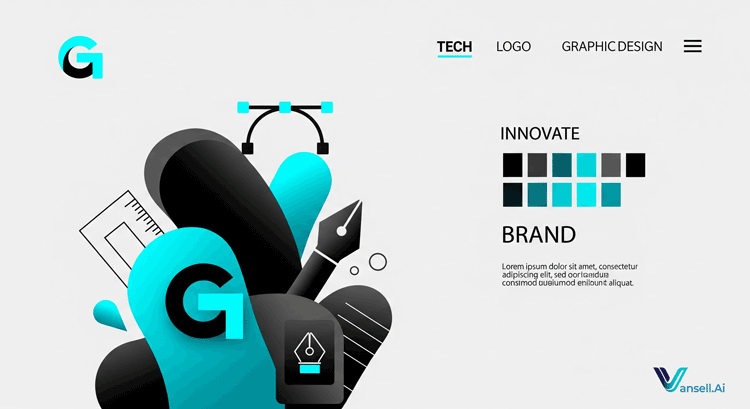The Role of Graphics in Web Design: Boost Your Brand Success
Learn how professional graphic design enhances web aesthetics, strengthens brand identity, and improves user engagement for lasting online impact.

- hirbodchoobak@gmail.com
- ⏱ 8 min read
The Role of Graphics in Web Design: How a Professional Graphic Designer Helps Brand Success
In today’s visually driven online world, a brand’s image is as important as its products or services. Web design is not just about coding or arranging content — it’s about creating a visually appealing, functional, and memorable digital experience. At the heart of this process lies graphic design, which plays a pivotal role in communicating your brand’s story and values.
Understanding the Connection Between Graphic Design and Web Design
While web design focuses on the structure, layout, and functionality of a website, graphic design deals with the visual elements that make the site engaging and recognizable. This includes typography, color palettes, images, illustrations, icons, and even branding assets like logos.
When both disciplines work together, the result is a website that is not only easy to use but also visually captivating.
Why Graphics Matter in Web Design
First Impressions Count
Users form opinions about a website within seconds. Striking visuals can instantly create a positive impression and encourage visitors to explore further.Strengthening Brand Identity
Consistent use of colors, typography, and imagery reinforces your brand identity. Graphics communicate brand personality in ways words alone cannot.Enhancing User Experience
Thoughtfully designed visuals guide users through content, making navigation intuitive and enjoyable.Boosting Engagement
Compelling images, infographics, and illustrations capture attention and encourage users to interact with your content.Improving Communication
Visuals can simplify complex information, making it easier for users to understand key messages.
The Role of a Professional Graphic Designer in Brand Success
Translating Brand Values into Visuals
A professional designer understands your brand’s mission and vision, then translates them into visual elements that resonate with your target audience.Creating Consistent Design Systems
They develop style guides to ensure visual consistency across all platforms, from your website to social media.Crafting Unique and Memorable Logos
Your logo is often the first thing users associate with your brand. A skilled designer ensures it’s distinctive, scalable, and timeless.Enhancing Website Aesthetics and Functionality
Designers know how to balance beauty with usability, ensuring visuals support — not hinder — the user experience.Optimizing Graphics for Performance
Large image files can slow down a site. Professional designers create optimized visuals that load quickly without sacrificing quality.
Key Graphic Elements in Effective Web Design
Color Scheme: Defines mood, emotion, and brand tone.
Typography: Improves readability and adds personality.
Icons: Provide quick, visual cues for actions or information.
Photography & Illustrations: Bring authenticity and depth to content.
Infographics: Present data in an easy-to-digest format.
Whitespace: Creates balance and focus in layouts.
How Graphics Influence User Behavior
Emotional Impact: Colors and imagery evoke emotions that influence decision-making.
Guided Navigation: Arrows, icons, and visual hierarchy direct users to important content.
Trust Building: High-quality visuals signal professionalism and reliability.
Tips for Using Graphics Effectively in Web Design
Keep it Consistent: Use a unified color palette and style throughout your site.
Prioritize Quality: Invest in professional photography or illustrations.
Optimize for Speed: Compress images to improve load times.
Focus on Relevance: Every visual should serve a purpose.
Use Responsive Design: Ensure graphics look great on all devices.
Follow Accessibility Guidelines: Provide alt text for images and ensure sufficient contrast.
Common Mistakes to Avoid
Using low-resolution or stocky-looking images.
Overloading pages with too many visuals.
Ignoring mobile optimization.
Inconsistent style that confuses brand identity.
Failing to update outdated graphics.
Tools for Graphic Design in Web Projects
Adobe Photoshop & Illustrator: Industry-standard tools for image and vector creation.
Figma: Collaborative design platform.
Canva: Easy-to-use tool for non-designers.
Sketch: Popular with interface and web designers.
Affinity Designer: Cost-effective alternative to Adobe tools.
The Future of Graphics in Web Design
Trends like 3D visuals, immersive animations, and AI-generated graphics are reshaping how brands present themselves online. However, while trends evolve, the principles of clarity, consistency, and brand alignment remain timeless.
Conclusion
Graphics are the visual heartbeat of web design, turning functional websites into engaging brand experiences. A professional graphic designer doesn’t just “make things look nice” — they create visual systems that communicate your brand’s identity, build trust, and inspire action.
Investing in high-quality graphics is investing in the long-term success of your brand.https://vansell.ai/web-design/

